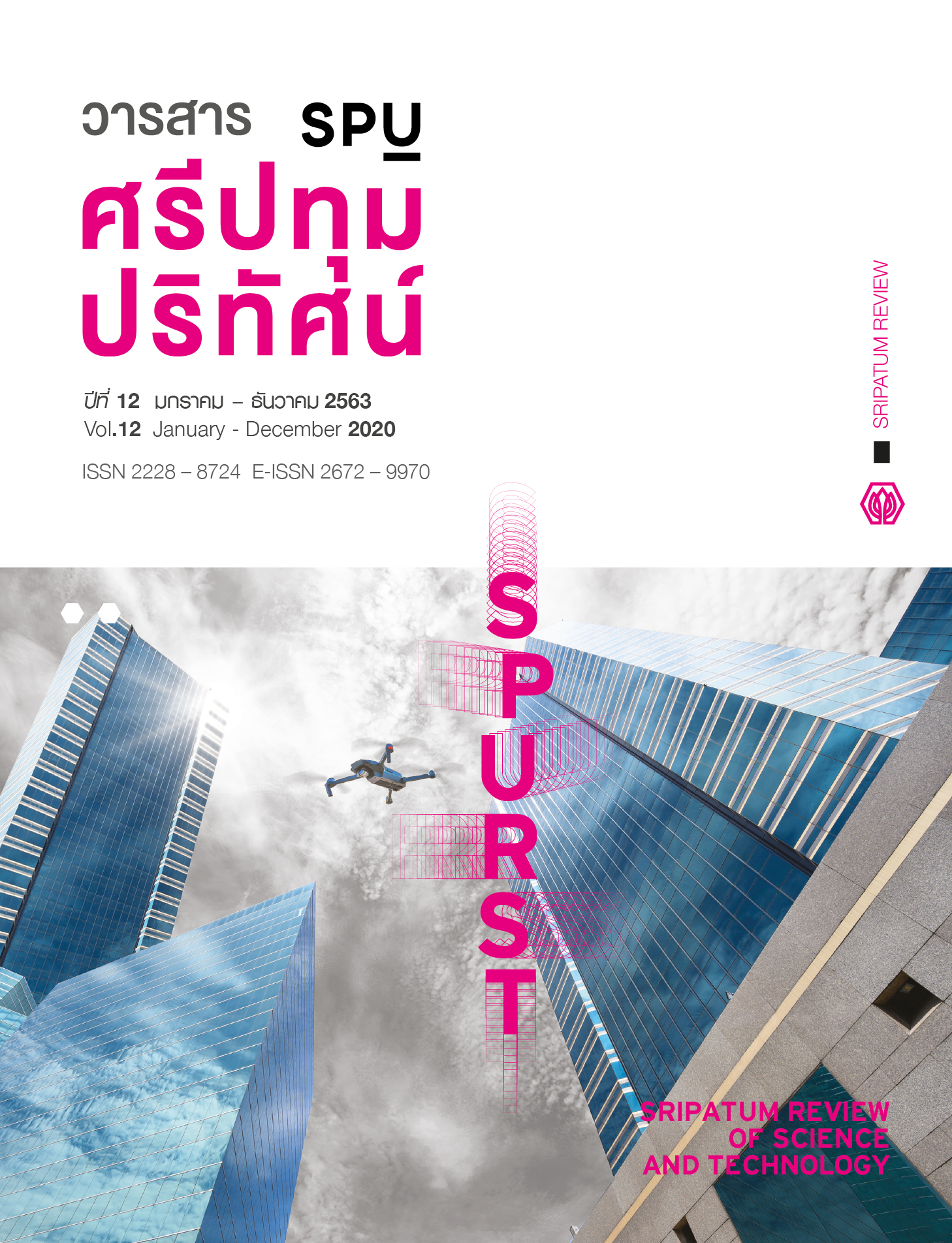Applying aerial imagery from Unmanned Aerial Vehicle for digital maps
Main Article Content
Abstract
The aim of this research is to use a small Unmanned Aerial Vehicle (UAV) for aerial photography to develop a digital map. This research is conducted applying geo-information technology for the desired results. The data collection is twofold. The first part is an acquisition of aerial photography using UAV which involves the remote sensing technology. The second part is an extraction of earth-surface features in a case study area from which the descriptive data is collected. With regard to data processing, the Drone Deploy platform is used for both managing UAV flight plan, and processing aerial images through the Drone Deploy cloud system to produce an orthophoto. Furthermore, the use of Global Positioning System (GPS) technology is necessary in this research for determining ground control points, which are later used for a geo-referencing operation to yield an orthomosaic map using QGIS software. A case study of Navaminda Kasatriyadhiraj Royal Air Force Academy (NKRAFA) illustrates the proposed methodology. As a result, in the QGIS environment, the vector features are digitized on such the base map with their attribute tables, which form the digital map of NKRAFA. This developed digital map can be used to displaying spatial data and as well as manipulating the data to support decision makings regrading spatial issues more efficiently.
Article Details
References
Boochayan, A., Pahanich, W., and Sartsin, P. (2018). Geo-information technology and geo-literacy. Humanities and Social Sciences Surindra Rajabhat University Journal, 20(2), 385-397. (in Thai)
Boonlua, T. (2014). The adaptive use of Unmanned Aerial Vehicle in aerial photography for urban design: a case study of Mahasarakham University, Khamreing Campus. Academic Journal of Architecture, 63, 55-68. (in Thai)
Huapai, S., and Banditwattanawong, T. (2017). The use of ontological engineering principle to develop a knowledge base for interoperability of multi-cloud computing platforms. Sripatum Review of Science and Technology, 9, 45-56. (in Thai)
Jeefoo, P. (2018). Application development for web-based GIS. Bangkok: Chulalongkorn University. (in Thai)
Jirakajohnkool, S. (2012). ArcGIS 10.1 for desktop. Nonthaburi: A.P. Graphic design & Printing Ltd. (in Thai)
Kriangkraipetch, S., and Liengwanpon, C. (2016). Geographic Techniques. Bangkok: Darnsutha Press Ltd. (in Thai)
Lilitwarangkul, T. (2005). Digital photogrammetry surveying technique. Thaksin University Journal, 8(1), 69-73. (in Thai)
Matese, A., Toscano, P., Gennaro, S. F. D., Genesio, L., Vaccari, F. P., Primicerio, J. et al (2015). Intercomparison of UAV, aircraft and satellite remote sensing platforms for precision viticulture. Remote Sensing, 7, 2971-2990.
Mongkolkeha, O. (2007). Global positioning system (GPS) towards global innovations of IT era. Advanced Sciences Journal, 7(2), 6-18. (in Thai)
National Resources Canada. (2016). Concepts of aerial photography. [Online]. Retrieved 23 June 2019, from: https://www.nrcan.gc.ca/earth-sciences/geomatics/
Phrommas, R. (2016). Aerial photography: an alternative endorsement of brand advertising. Research and Innovation and National Development. The Proceedings of the 12th Naresuan Research Conference, 21-22 July 2016 at Naresuan University, 2094-2105. (in Thai)
Royal Thai Survey Department, Royal Thai Armed Force Headquarters. (2015). The evolution of surveying in Thailand from the past to the present. [Online]. Retrieved 9 July 2019, from: https://www.rtsd.mi.th/main/2015 (in Thai)
Stensaas, G.L. (2007). U.S. Geological survey digital aerial mapping camera certification and quality assurance plan for digital imagery. In: Fritsch, D (ed) Photogrammetric week ’07. Wichmann, Heidelberg, 107–116.
Suksabai, K., and Nakhapakorn, K. (2014). Fire detection using LANDSAT thermal data: in Saiyok district, Kanchanaburi province, Thailand. Thai Science and Technology Journal, 22(4), 462-473. (in Thai)
Thitisawan, V. (2001). The application of a geographic information system to carbonate rock resources management, Ratchaburi province. Thesis of the Degree of Master of Science in Technology of Environmental Management. Nakhon Pathom: Mahidol University. (in Thai)
Semuagngam, A. (2018). Using sUAV for data collection in planning: a case study of Jompol road, Nakhon Ratchasima. RMUTI Journal Science and Technology, 11(2), 25-39. (in Thai)
Thongtip, U. (2012). Geographic information system for a local study. Bangkok: Phranakhon Rajabhat University. (in Thai)
Wingtra. (2019). How ground sample distance (GSD) relates to accuracy and drone ROI. [Online]. Retrieved 28 July 2019, from: https://wingtra.com/how-ground-sample-distance-gsd-relates-to-accuracy-and-drone-roi/
Yiengveerachon, V. (2016). Surveying: theory and applications. 8th ed. Bangkok: Chulalongkorn University. (in Thai)


